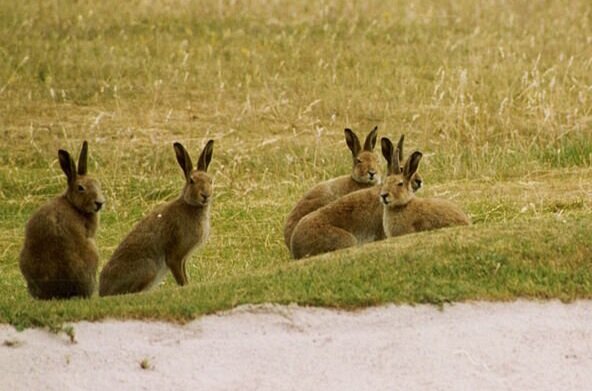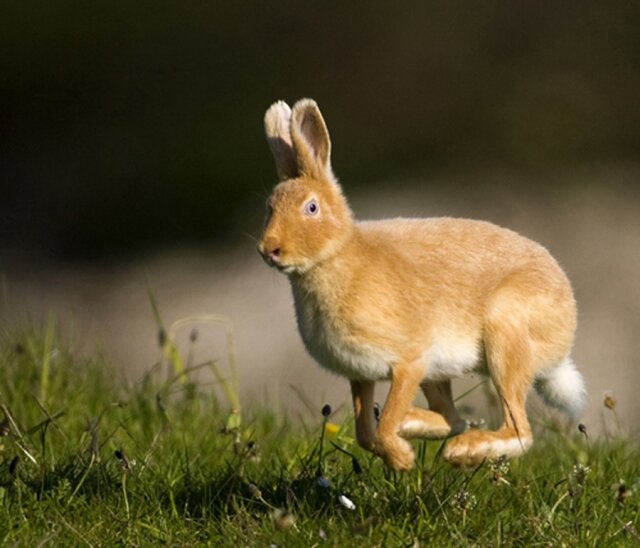Mountain hare in its winter coat (credit: Bouke ten Cate)
Fact file
Latin name
Lepus timidus
Threat status
Least Concern (Global)
Least Concern (Europe)
Near Threatened (UK)
Etymology
The Latin name for mountain hare translates directly from Latin as ‘Shy’ (timidus) ‘Hare’ (lepus).
Males hares are known as bucks or jacks, whilst females hares are does or jills. Baby hares are called leverets.
Identifying features
Mountains hares are similar to rabbits, but with longer legs in proportion to their body and black tips to their ears. Their coats change colour depending on the season (see more below), so they are brown in summer and white in winter. In summer, they can be distinguished from brown hares as their fur is a greyer-brown, and they are smaller and have shorter ears.
Mountains hares are sometimes known as blue hares, due to their blue-grey fur!
Habitat
Most commonly found in open moorland with lots of grass and heather, but can occupy habitats that are a mixture of upland, grassland and woodland. In Ireland, they can also be found in lowland, coastal and agricultural grassland, but not where they are intensively used (see more on Irish Hares below).
Numbers
In The UK the current population estimate is 135,000 (95% CI: 81,000 - 526,000) individuals, from the Mammal Society Review of the Population and Conservation Status of British Mammals. They can reach densities of up to 200 hares per kilometre squared, but more often there are only 30-69. They seem to have weak population cycles, with high numbers every 5 to 15 years, though the cause is uncertain.
Distribution
Globally, mountain hares are found across Eurasia, from the UK and Scandinavia in the west to the furthest eastern point of Russia and parts of Japan. There is also an isolated remnant population in the Alps.
In the UK, mountains hares are found throughout Ireland and the highlands of Scotland, as well as on several islands including Skye, Shetland and the Isle of Man. There is also a small population in the Peak District.
Diet
Mountain hares are herbivorous, and their diets mostly consist of heather species (especially in winter), as well as grasses and sedges. They also occasionally eat the bark and twigs of bushes and small trees.
Size
An adults hare’s head and body can be 45.7 to 54.5cm long, whilst their hind legs range from 12.7 to 15.5cm and their ears from 6.3 to 8cm. They weigh around 2.5 to 3.5 kg, with females slightly heavier than males.
Life span
3-4 years.
Breeding
Mountain hares breed from mid-March to mid-August, and can have up to 4 litters per season as gestation occurs at the same time as lactation for the previous litter. They have 1-4 offspring (called leverets) per litter, which are born fully furred and with their eyes open. The leverets mostly fend for themselves for the roughly 4 weeks of parental care, with only suckling visits from their mum.
Mountain hare in its summer coat (credit: Mike Pennington)
Survey techniques
Hares are timid, well-camouflaged and active at night, so they are very difficult to survey. Most of the current UK population knowledge comes from counts when they are hunted.
There are also a few signs to look out for: they often make trails through vegetation, usually orientated up/down hill; their faeces is similar to rabbit, though slightly larger, though it is indistinguishable from brown hare; and they also hide in ‘forms’ - depressions in dense vegetation where they can rest and hide.
Changing colour
Mountain hare mid-moult, showing patchy color (credit: John Fielding)
Mountain hares moult twice a year so they can change their coat colour and remain camouflaged to hide from predators. In summer they are brown to blend in with moorland vegetation, and in winter they are white to match snow. However, when they are shedding and regrowing their fur in spring and autumn they will have patchy coats and may be more obvious to hunters. Also, if there is little or no snow in winter, as may occur with climate change, their white winter coats will no longer be camouflaged and they will be more vulnerable to predation.
Irish hares
Irish hares in coastal habitat (credit: Alan Wolfe)
The Irish hare (Lepus timidus hibernicus - hibernicus is the Latin version of Ireland) is a subspecies of the mountain hare, that can be distinguished by its genetics and appearance. Irish hares are slightly bigger than mountain hares, with a head/body 52.1 to 55.9cm long. They are also more red-brown in colour, especially in summer, and rarely fully change fur colour in winter, though patches of white on the feet and belly are common. This subspecies is widespread across Ireland, and is more often found in grassland, including agricultural land, than mountain hares. Otherwise, Irish hares have a similar diet and breeding biology.
The Irish hares on the island of Rathlin are extra-special; some of the individuals have pale blond fur and bright blue eyes! These ‘golden hares’ are likely due to the genetic ‘founder effect’ - the small number of individuals that founded the islands population may have had a disproportionate number of this rare genetic trait, which then becomes more prevalent in the population as the population grows.
A golden hare on Rathlin Island (credit: Tom McDonnell)





